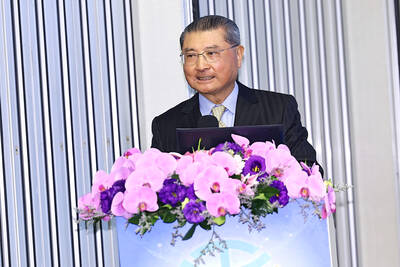Japan yesterday reported its fastest rise in core consumer prices in almost a decade as sky-rocketing energy costs help to lift Asia's largest economy out of years of deflation.
Meanwhile, the jobless rate fell unexpectedly as household spending and industrial output dropped, according to a raft of data for last month that painted a mixed picture of the health of the Japanese economy.
Core consumer prices climbed 0.4 percent last month from a year earlier, the largest gain since March 1998, the government said.
Market forecasts had been for a rise of 0.3 percent after October's 0.1 percent gain, which snapped an eight-month losing streak.
Higher energy prices were largely behind the pick-up in inflation, which is likely to slow as global oil prices stabilize, said Mamoru Yamazaki, chief economist for RBS Securities in Tokyo.
"However, even if the contribution of oil products becomes low, I believe that the CPI [consumer price index] will remain in positive territory," he said, predicting a 0.6 percent gain in core consumer prices this month.
The core CPI for the Tokyo area -- a leading indicator released a month earlier than the nationwide index -- rose 0.3 percent this month year-on-year.
Despite the return to positive inflation, economists doubt the Bank of Japan will raise interest rates again until midway through next year at the earliest.
Japan's economy is gradually recovering from a slump stretching back more than a decade, but growth this year has fallen short of expectations amid a shaky global economy and a slump in the domestic housing market.
Small firms in particular are struggling at the moment against a backdrop of soaring oil prices and higher borrowing costs.
The unemployment rate fell to 3.8 percent last month from 4.0 percent the previous month. Unemployment declined by 130,000 from a year earlier to 2.46 million last month, the 24th consecutive monthly fall, the government said.
The unemployment rate is now just above a trough of 3.6 percent seen in July, which was the lowest rate since February 1998.
Even so there were only 99 jobs available for every 100 job seekers, down from 102 in October and 105 in September, the government said.
It was the first time in two years that there were fewer available jobs than job seekers.
Yamakazi said: "Looking at surveys, many corporations are facing labor shortages."
"However, corporations seem to be cautious about increasing their number of employees aggressively given the worsening business conditions," he said.
Despite low unemployment, wage growth remains sluggish due to demographic changes and corporate Japan's reluctance to raise salaries amid fierce competition with rivals in China and other emerging markets.
The government maintained its overall assessment that industrial production "is on a moderately upward trend," predicting that industrial output will rise by 4.0 percent this month from a month earlier, but stay flat next month.

When an apartment comes up for rent in Germany’s big cities, hundreds of prospective tenants often queue down the street to view it, but the acute shortage of affordable housing is getting scant attention ahead of today’s snap general election. “Housing is one of the main problems for people, but nobody talks about it, nobody takes it seriously,” said Andreas Ibel, president of Build Europe, an association representing housing developers. Migration and the sluggish economy top the list of voters’ concerns, but analysts say housing policy fails to break through as returns on investment take time to register, making the

‘SILVER LINING’: Although the news caused TSMC to fall on the local market, an analyst said that as tariffs are not set to go into effect until April, there is still time for negotiations US President Donald Trump on Tuesday said that he would likely impose tariffs on semiconductor, automobile and pharmaceutical imports of about 25 percent, with an announcement coming as soon as April 2 in a move that would represent a dramatic widening of the US leader’s trade war. “I probably will tell you that on April 2, but it’ll be in the neighborhood of 25 percent,” Trump told reporters at his Mar-a-Lago club when asked about his plan for auto tariffs. Asked about similar levies on pharmaceutical drugs and semiconductors, the president said that “it’ll be 25 percent and higher, and it’ll

CHIP BOOM: Revenue for the semiconductor industry is set to reach US$1 trillion by 2032, opening up opportunities for the chip pacakging and testing company, it said ASE Technology Holding Co (日月光投控), the world’s largest provider of outsourced semiconductor assembly and test (OSAT) services, yesterday launched a new advanced manufacturing facility in Penang, Malaysia, aiming to meet growing demand for emerging technologies such as generative artificial intelligence (AI) applications. The US$300 million facility is a critical step in expanding ASE’s global footprint, offering an alternative for customers from the US, Europe, Japan, South Korea and China to assemble and test chips outside of Taiwan amid efforts to diversify supply chains. The plant, the company’s fifth in Malaysia, is part of a strategic expansion plan that would more than triple

Taiwanese artificial intelligence (AI) server makers are expected to make major investments in Texas in May after US President Donald Trump’s first 100 days in office and amid his rising tariff threats, Taiwan Electrical and Electronic Manufacturers’ Association (TEEMA, 台灣電子電機公會) chairman Richard Lee (李詩欽) said yesterday. The association led a delegation of seven AI server manufacturers to Washington, as well as the US states of California, Texas and New Mexico, to discuss land and tax issues, as Taiwanese firms speed up their production plans in the US with many of them seeing Texas as their top option for investment, Lee said. The